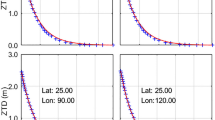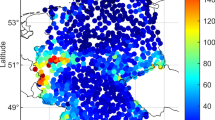Abstract
Troposphere-induced errors in GPS-derived geodetic time series, namely, height and zenith total delays (ZTDs), over Japan are quantitatively evaluated through the analyses of simulated GPS data using realistic cumulative tropospheric delays and observed GPS data. The numerical simulations show that the use of a priori zenith hydrostatic delays (ZHDs) derived from the European Centre for Medium-Range Weather Forecasts (ECMWF) numerical weather model data and gridded Vienna mapping function 1 (gridded VMF1) results in smaller spurious annual height errors and height repeatabilities (0.45 and 2.55 mm on average, respectively) as compared to those derived from the global pressure and temperature (GPT) model and global mapping function (GMF) (1.08 and 3.22 mm on average, respectively). On the other hand, the use of a priori ZHDs derived from the GPT and GMF would be sufficient for applications involving ZTDs, given the current discrepancies between GPS-derived ZTDs and those derived from numerical weather models. The numerical simulations reveal that the use of mapping functions constructed with fine-scale numerical weather models will potentially improve height repeatabilities as compared to the gridded VMF1 (2.09 mm against 2.55 mm on average). However, they do not presently outperform the gridded VMF1 with the observed GPS data (6.52 mm against 6.50 mm on average). Finally, the commonly observed colored components in GPS-derived height time series are not primarily the result of troposphere-induced errors, since they become white in numerical simulations with the proper choice of a priori ZHDs and mapping functions.
Similar content being viewed by others

References
Agnew DC (1997) NLOADF: a program for computing ocean-tide loading. J Geophys Res 102(B3): 5109–5110
Bar-Sever YE, Kroger PM, Borjesson JA (1998) Estimating horizontal gradients of tropospheric path delay with a single GPS receiver. J Geophys Res 103(B3): 5019–5035
Boehm J, Werl B, Schuh H (2006a) Troposphere mapping functions for GPS and very long baseline interferometry from European Centre for Medium-Range Weather Forecasts operational analysis data. J Geophys Res 111: B02406. doi:10.1029/2005JB003629
Boehm J, Niell A, Tregoning P, Schuh H (2006b) Global mapping function (GMF): a new empirical mapping function based on numerical weather model data. Geophys Res Lett 33: L07304. doi:10.1029/2005GL025546
Boehm J, Heinkelmann R, Schuh H (2007) A global model of pressure and temperature for geodetic applications. J Geod 81(10): 679–683. doi:10.1007/s00190-007-0135-3
Dach, R, Hugentobler, U, Fridez, P, Meindl, M (eds) (2007) Bernese GPS software version 5.0 user manual. Astronomical Institute, University of Bern, Bern
Davis JL, Herring TA, Shapiro II, Rogers AEE, Elgered G (1985) Geodesy by radio interferometry: effects of atmospheric modeling errors on estimates of baseline length. Radio Sci 20(6): 1593–1607
Dow JM, Neilan RE, Rizos C (2009) The International GNSS Service in a changing landscape of Global Navigation Satellite Systems. J Geod 83(3–4): 191–198. doi:10.1007/s00190-008-0300-3
Gurtner W, Estey L (2007) RINEX: the receiver independent exchange format version 2.11. IGS Central Bureau. http://igscb.jpl.nasa.gov/igscb/data/format/rinex211.txt. Accessed 08 December 2009
Hatanaka Y, Sawada M, Horita A, Kusaka M (2001) Calibration of antenna-radome and monument-multipath effect of GEONET-Part 1: measurement of phase characteristics. Earth Planets Space 53(1): 13–21
Haurwitz B (1941) Dynamic meteorology. McGraw-Hill, New York
Heki K (2001) Seasonal modulation of interseismic strain buildup in north-eastern Japan driven by snow loads. Science 293(5527): 89–92
Hobiger T, Ichikawa R, Takasu T, Koyama Y, Kondo T (2009) Ray-traced troposphere slant delays for precise point positioning. Earth Planets Space 60(5): e1–e4
JMA (2007) Outline of the operational numerical weather prediction at the Japan Meteorological Agency. Japan Meteorological Agency. http://www.jma.go.jp/jma/jma-eng/jma-center/nwp/outline-nwp/index.htm. Accessed 15 December 2009
Kouba J (2008) Implementation and testing of the gridded Vienna mapping function 1 (VMF1). J Geod 82(4–5): 193–205. doi:10.1007/s00190-007-0170-0
Kouba J (2009) Testing of global pressure/temperature (GPT) model and global mapping function (GMF) in GPS analyses. J Geod 83(3–4): 199–208. doi:10.1007/s00190-008-0229-6
Langbein J, Johnson H (1997) Correlated errors in geodetic time series: Implications for time-dependent deformation. J Geophys Res 102(B1): 591–603
Matsumoto K, Takanezawa T, Ooe M (2000) Ocean tide models developed by assimilating TOPEX/POSEIDON altimeter data into hydrodynamical model: a global model and a regional model around Japan. J Oceanogr 56(5): 567–581
Matsumoto K, Sato T, Takanezawa T, Ooe M (2001) GOTIC2: a program for computation of oceanic tidal loading effect. J Geod Soc Jpn 47: 243–248
Miyazaki S, Saito T, Sasaki S, Hatanaka Y, Iimura Y (1997) Expansion of GSI’s nationwide GPS array. Bull Geogr Surv Inst 43: 23–34
Munekane H (2005) A semi-analytical estimation of the effect of second-order ionospheric correction on the GPS positioning. Geophys J Int 163(1): 10–17. doi:10.1111/j.1365-246X.2005.02723.x
Munekane H (2007) Ocean mass variations from GRACE and tsunami gauges. J Geophys Res 112: B07403. doi:10.1028/2006JB004618
Munekane H, Kuroishi Y, Hatanaka Y, Yarai H (2008) Spurious annual vertical deformations over Japan due to mismodelling of tropospheric delays. Geophys J Int 175(3): 831–836. doi:10.1111/j.1365-246X.2008.03980.x
Niell AE (1996) Global mapping functions for the atmosphere delay at radio wavelengths. J Geophys Res 101(B2): 3227–3246
Nilsson T, Davis JL, Hill EM (2009) Using ground-based GPS to characterize atmospheric turbulence. Geophys Res Lett 36: L16807. doi:10.1029/2009GL040090
Ohtsuka T, Takahashi H, Fukushima Y, Isaka T, Masaharu H (1997) Expression of three-dimensional space with digital cartographic data and computer graphics method. Bull Geogr Surv Inst 43: 35–41
Penna NT, King MA, Stewart MP (2007) GPS height time series: Short-period origins of spurious long-period signals. J Geophys Res 112: B02402. doi:10.1029/2005J004047
Press WH, Teukolsky SA, Vetterling WT, Flannery BP (1992) Numerical recipes in Fortran 77, 2nd edn. Cambridge University Press, Cambridge
Ray J, Altamimi Z (2005) Evaluation of co-location ties relating the VLBI and GPS reference frames. J Geod 79(4–5): 189–195. doi:10.1007/s00190-005-0456-z
Ray J, Altamimi Z, Collilieux X, van Dam T (2008) Anomalous harmonics in the spectra of GPS position estimates. GPS Solut 12(1): 55–64. doi:10.1007/s10291-007-0067-7
Shoji Y, Kunii M, Saito K (2009) Assimilation of nationwide and global GPS PWV data for a heavy rain event on 28 July 2008 in Hokuriku and Kinki, Japan. SOLA 5: 45–48. doi:10.2151/sola.2009-012
Steigenberger P, Boehm J, Tesmer V (2009) Comparison of GMF/GPT with VMF1/ECMWF and implications for atmospheric loading. J Geod 83(10): 943–951. doi:10.1007/s00190-009-0311-8
Tapley BD, Bettadpur S, Ries JC, Thompson PF, Watkins MM (2004) GRACE measurements of mass variability in the Earth system. Science 305(5683): 503–506
Tregoning P, Herring TA (2006) Impact of a priori zenith hydrostatic delay errors on GPS estimates of station heights and zenith total delays. Geophys Res Lett 33: L23303. doi:10.1029/2006GL027706
Tregoning P, Watson C (2009) Atmospheric effects and spurious signals in GPS analyses. J Geophys Res 114: B09403. doi:10.1029/2009JB006344
Williams SDP, Bock Y, Fang P, Jamason P, Nikolaidis RM, Prawirodirdjo P (2004) Error analysis of continuous GPS position time series. J Geophys Res 109: B03412. doi:10.1029/2003JB002741
Zumberge JF, Heflin MB, Jefferson DC, Watkins MM, Webb FH (1997) Precise point positioning for the efficient and robust analysis of GPS data from large network. J Geophys Res 102(B3): 5005–5018
Author information
Authors and Affiliations
Corresponding author
Rights and permissions
About this article
Cite this article
Munekane, H., Boehm, J. Numerical simulation of troposphere-induced errors in GPS-derived geodetic time series over Japan. J Geod 84, 405–417 (2010). https://doi.org/10.1007/s00190-010-0376-4
Received:
Accepted:
Published:
Issue Date:
DOI: https://doi.org/10.1007/s00190-010-0376-4



